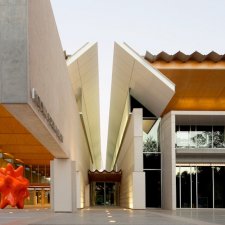- About us
- Support the Gallery
- Venue hire
- Publications
- Research library
- Organisation chart
- Employment
- Contact us
- Make a booking
- Onsite programs
- Online programs
- School visit information
- Learning resources
- Little Darlings
- Professional learning
Tommy Tycho AM MBE (1928-2013), musician, began studying at the Conservatorium of Music in his native Budapest at the age of eight. At ten, he played Rhapsody in Blue with the Hungarian Philharmonic. Interned with his Jewish mother, a soprano, in World War 2, he returned to the Franz Liszt Academy and began to play with popular bands; with the installation of the Communist government in Hungary he went to Turkey and proceeded to Iran, where he became the personal pianist to the Shah. In 1951 he and his Hungarian soprano wife Eva came to Australia, where they found work at David Jones. In 1954 he began working for the ABC on A Handful of Keys; three years later, he commenced with Channel Seven, becoming one of the first familiar faces on Australian television as the orchestral director of In Sydney Tonight. He scored various hit television series, including the Mavis Bramston Show, while he made records, appeared on radio, arranged recordings for other artists and composed music. He directed nine Command Performances and finished his career with more than 70 albums to his name. On the side, he did a great deal of work for charity. His memoir, The Tommy Tycho Story: Music Maestro Please was published in 1995 and he received an honorary doctorate from the University of Sydney in 2007.
Calvin Winetroube (1945-2005) came to Australia from England in 1981 as a drummer on a cruise ship. Settling in Sydney, for many years he drummed at City Tattersall’s, Willoughby RSL and Dee Why RSL. In time, his amateur interest in photographing performers in his own milieu grew into a second career. He photographed the Mo presentations and ‘Catch a Star’ nights for twenty years and produced several magazines for variety artists including That’s Entertainment, Live Entertainment and Skinfull
(a periodical for percussionists).
Collection: National Portrait Gallery
Gift of Vicky Tycho 2013
Vicky Tycho (1 portrait)



On one level The Companion talks about the most famous and frontline Australians, but on another it tells us about ourselves.



Visit us, learn with us, support us or work with us! Here’s a range of information about planning your visit, our history and more!



We depend on your support to keep creating our programs, exhibitions, publications and building the amazing portrait collection!